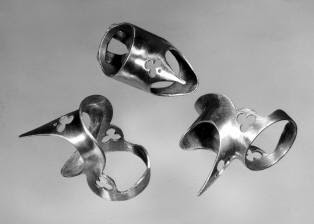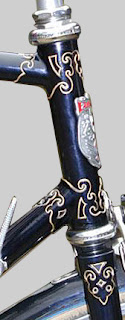Lugs
 Fri, October 5, 2007
Fri, October 5, 2007  A bike store owner told me recently told me of a young customer in his store looking at a 1980s vintage steel bike that was in for a service. He pointed to the lugs and asked the store owner, “What are these for?”
A bike store owner told me recently told me of a young customer in his store looking at a 1980s vintage steel bike that was in for a service. He pointed to the lugs and asked the store owner, “What are these for?”
I find it amazing that a method of building bicycles can be around for over a 100 years, and become lost to a new generation in ten years or so.
Since the bicycle’s invention in the late 1800s the traditional way to join steel tubes to make a bicycle frame was by melting brass into a lugged joint. Similar in a way to a plumber joining copper pipe by sliding the pipe into a pipefitting, heating, and filling the joint with solder.
Brazing, as it is known, done at a higher temperature and the resulting joint is much stronger. Early lugs were in fact pipefittings; these were heavy steel sand castings, cut square at the edges, and machined on the inside to fit the tube.
As steel tubing for bicycles became thinner and lighter, it was found the tube would sometimes break at the edge of the lug. This was because the lug was far stronger than the tube.
In any structure, if you make a joint far stronger than the parent material, the material will fail during stress, immediately adjacent to the joint. Framebuilders started filing the lugs thinner to bring the strength closer to that of the tube. For the same reason, they also started cutting the lugs into fancy shapes to eliminate the square edge of the lug.
By the 1950s the cutting and filing of lugs became the way a framebuilder would express his art and individuality. Hetchins (Left.) were one of the first to take this art to extremes.
By the 1960s and 1970s, fancy lugwork became too costly and lugs stamped from sheet steel and welded, became available. The top picture is a set of pressed steel lugs that I prepared during the 1970s, with some custom shaping a cutout work.
By the 1980s “Investment” cast lugs became available. A method developed for the aircraft industry, investment casting was achieved by first hand making a lug. From this “pattern” lug a simple plaster mould was made.
A lug made of wax was cast in the plaster mold; this in turn was coated in a ceramic material and fired in an oven. The firing hardened the ceramic coating and at the same time melted the wax from inside, leaving a void the perfect shape of a lug.
Molten steel was poured into the mold, and when cooled the ceramic mold had to be broken to remove the finished lug, hence the name, “Investment” casting. An expensive process, but the finished lug was near perfect, the tubes fit with no machining required; very little filing required from the framebuilder. Lugs, bottom bracket shells, and fork crowns are made this way.
Traditionally frames were never welded. Not because welding was not strong enough but rather the heat required to weld weakened the parent material adjacent to the weld. By the 1980s welding technology had advanced to where it could have been used to build lightweight frames. However, at the time customers, connoisseurs of the lugged frame would not accept it.
This changed during the “death” of the road bike in the early 1990s. Mountain bike manufactures could get away with the quicker and cheaper welding process, because the MTB was new and there were not the old standards, and traditions to break down. There was a whole new generation who grew up with welded BMX bikes.
When the road bike was reborn, sadly, for some of us it was an ugly bastard. Its gene pool contaminated by MTB and BMX, the beauty, style and class bred out of it. A well, that is I suppose the price we pay for progress.
 Dave Moulton | Comments Off |
Dave Moulton | Comments Off | 

















Reader Comments (13)
Perhaps this is why you are an ex-framebuilder. This form over function trend in cycling is the entire basis for the fixed gear backlash. If you don't like modern, lightweight, poorly welded frames, put the typewriter down, stamp out some lugs, and whip youself up a real beaut. Tip the scales! You can control the medium, if you please.
P.S. You may want to check out the amazing sharpie detail on FGG that the kids are doing on lugs these days! It's all the rage!
Still, I'm not too enamored of those aluminum frames with welds that look like painted toothpaste, though it's undoubtedly utilitarian and a means of putting together a quality product at an affordable price.
The ornate steel lugs are for the carriage trade these days.
"Fear not, many current 'vogue' frames employ lug and tube construction methods for joining aerospace materials."
Abide well disguised!
There is nothing as beautiful as a Fixed Gear with a Lugged Steel Frame.
UNQUOTE
I disagree with that commenter's view. There is nothing as beautiful, elegant and graceful in the entire mechanical world as a well-made lugged steel racing bike.
Today's typical production bikes look like Transformers robots in comparison, or a bit like light motorcycles without an engine. They only look mildly proportioned if the saddle is a foot higher than the top tube and the handlebars a foot and a half lower, and even then, it takes a lot of stuck-on or painted-on graphics to make them look acceptable.
A lot of the 70-80s quality steel frames are very inexpensive (especially Asian) and often are picked up for under $100 for convertion to fixed gear. I'm all for it. It gives them a new life on the road. A friend of mine recently found an early 70s OLMO frame that looked like a throwaway. The frame finish was shot and there was rust and lots of nicks and scrapes. With a lot of elbow grease, he buffed up the frame, and converted it to a fixed gear with a newer wheelset, stem and bar, seat and post, and it is now a bike with character and a new life.
Also, as much as I love lugs, there are some gorgeous frames being built which are lugless. Blame it on progress if you will, but the work is beautiful none-the-less. And, if were not for progress, I'd be carving this posting into a cave wall somewhere rather than posting via my computer.
Rubber side to the road...and ride!!
I rode lugged steel for a couple of decades before I knew what lugs were. I just rode the things; I've never built 'em. While I can appreciate the beauty of lugged steel frames, I don't have much aptitude for mechanical construction. I also appreciate the smooth curves of a nice handcrafted carbon frame.
I thought that was what I was doing here, passing on information. Many of the new generation are not interested in what has gone before.
They discover a fixed gear bike, and like discovering sex, they think they invented it and no one has ever done it before.